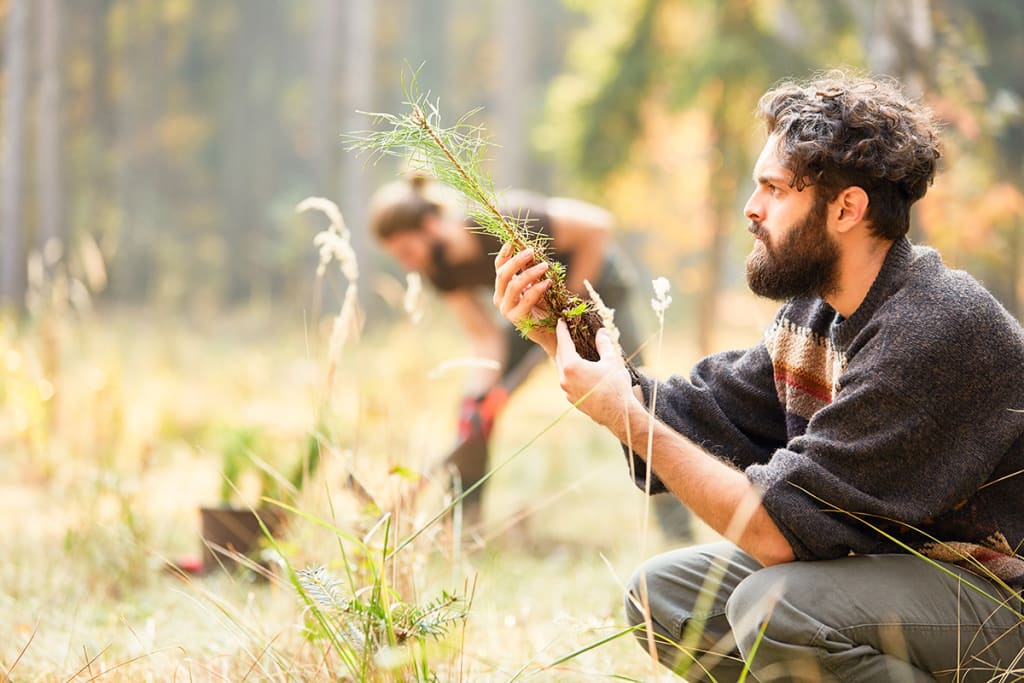REFORESTATION PLANS REQUIRE MORE THAN SAYING “PLANT MORE TREES”
Reforestation plans play a central role in global strategies to solve the climate crisis. Find out why simply getting millions of saplings into the ground doesn’t deliver long-term success.

Reforestation plans play a central role in global strategies to solve the climate crisis. Find out why simply getting millions of saplings into the ground doesn’t deliver long-term success.
Growing up, I remember noticing some very strange forests out the window of our family car. Every tree was the same, they were all lined up in exact rows at precisely the same distance from one another.
My dad explained that those were new forests that county workers had planted there by hand. When settlers like my ancestors came to this area, they thought every tree they saw was standing in the way of progress.
Pioneers spent most of their time on “the chopping,” along with burning the logs in massive, smoky bonfires people could see for miles. They let an unimaginable amount of what we would consider valuable timber go to waste.
LACK OF FORESTS CAUSED FLOODING AND EROSION
After a century or so, local governments realized the lack of forests caused flooding and erosion. At the same time, timber had become scarce and valuable.
So, the county came up with a reforestation plan for land along rivers and in other strategic spots. We’re now home to over 1,000 hectares (about the size of 25 standard farms) of planted forest.
What’s been happening locally is mirrored globally. Roughly one-third of the world’s land is forest-covered, with five countries containing most of those forests. Ranked by their forested land area, those nations are Russia, Brazil, Canada, the USA and China.
FORESTS HAVE GAINED OVER 1.3 MILLION SQUARE KILOMETRES
Over the last twenty years, forests have gained over 1.3 million square kilometers of area worldwide. That’s an area about the size of South Africa, Egypt or Columbia, and it’s bigger than most of the world’s countries.
Unfortunately, forest losses have offset those impressive gains. Overall, the world’s forest cover has declined by about a million square kilometres over the last two decades.
We also need to look critically at the way countries have achieved those gains. Most of the reforestation plans consisted of dense plantations of only one tree species.
UN HAS MADE THE 2020S THE DECADE OF ECOSYSTEM RESTORATION
Despite these shortcomings, worldwide reforestation efforts will continue. The UN has officially made the 2020s the Decade of Ecosystem Restoration.
At the COP 27 meeting on climate change last week, 26 member countries, along with the European Union, committed $16 billion to reforestation.
We’ve all heard that governments are making reforestation plans to absorb carbon emissions and help us cope with the climate crisis. The trouble is that, as with many other problems, merely throwing money at forest restoration doesn’t make ecological issues vanish.
NOBODY SEEMS TO REALLY KNOW HOW TO USE ALL THAT MONEY
Nobody seems to really know how to use all that money to drive such a massive reforestation effort. Despite all our planting efforts, 93% of the world’s forests are naturally regenerating and not plantations.
Last week, the Philosophical Transactions of the Royal Society published an entire issue on the theme of reforestation. One of the studies the issue included was an evaluation of reforestation plan results.
The researchers analyzed the data from a sample 176 reforestation areas in Asia. The locations represented a range of ecosystems, soil types and types of trees planted.
ONLY ABOUT 44% OF PLANTED TREES LIVED FIVE YEARS
The results were discouraging. Only about 44% of planted trees lived five years. In some places, the survival rate was less than one in five saplings.
The study made an important discovery. Planting close to existing, mature trees can improve that seedling survival rate to 64%.
It’s not completely clear why, but locations near mature trees seem to be less degraded than other areas. Keeping cattle away with fences and taking steps to improve the soil can also help, but these measures far more than simply looking for sites near established forests.
CHOOSING THE RIGHT SPECIES IS EVEN MORE IMPORTANT THAN THOUGHT
Another study published in the special issue found that choosing the right species of trees is even more important than previously thought. Some species establish themselves in new areas far more easily than others.
The team also found that reforestation plans need to balance active and passive restoration methods. Projects need to temper the eagerness for rapid reforestation with letting nature take its course.
To achieve this, the researchers recommend an approach they call the “framework species method” (FSM). The scientists call tree species that expedite natural forest regeneration “framework species.” They’ve come up with five traits that qualify trees for the framework.
FRAMEWORK SPECIES METHOD
These framework traits are:
Indigenous to the forest ecosystem being restored
Tolerant of open conditions
Attractive to seed-dispersing animals.
Able to inhibit weeds
Propagate easily
While choosing the right species is vital, so is finding the best places to plant them. Another study appearing in the special issue reviewed nine years of Brazilian restoration plans on the wastelands of abandoned tin mines.
The team found that quality soil and surrounding forests improved the chances for success. Pits surrounding the mine sites tended to regenerate naturally, while tailing dams needed much more attention, resources and support.
WELL-BEING OF PEOPLE LIVING IN REFORESTED COMMUNITIES
The people side of reforestation plans was the topic of yet another study in the themed issue. The researchers reviewed the well-being of people living in Tanzanian reforested communities.
The team looked at five dimensions of human well-being. The indicators included:
Material well-being
Health
Social Relations
Security
Freedom of Choice and Action
The scientists wanted to assess how community forests with certified sustainable management practices affected people’s well being. They found that certified community forests improved equitable governance and forest recovery, which in turn enhanced human well-being in the affected communities.
INDUSTRIAL THINKING CAN’T RESTORE NATURAL PROCESSES
Taken together, the journal’s new theme issue consistently reveals a fundamental underlying principle for reforestation plans. Industrial thinking can’t restore natural processes.
Trying to mass produce a forest by indiscriminately inserting huge numbers of uniform saplings into an arbitrarily-chosen tract of land is doomed to fail. If we’re genuinely committed to overcoming the climate crisis through reforestation, we have to learn to work with nature instead of trying to become its master.
CALL FOR BETTER INFORMATION SHARING
The operative word here is “learn.” The theme issue wraps up with a call for better information sharing.
The final article concludes with the statement, “To improve our collective understanding of restoration outcomes, we advocate improved practices and institutional and financial support for collecting and sharing restoration evidence.”
We always have more to learn if we dare to know.
Learn more:
Global Forest Resources Assessment
Understanding forest landscape restoration
Ecosystem Stability Determined by Two Simple Factors
Safeguarding Biodiversity Means Conserving 44% of Earth’s Land
‘Making Peace with Nature’ Report Offers Sustainable Blueprint
About the Creator
David Morton Rintoul
I'm a freelance writer and commercial blogger, offering stories for those who find meaning in stories about our Universe, Nature and Humanity. We always have more to learn if we Dare to Know.
Reader insights
Nice work
Very well written. Keep up the good work!
Top insights
Expert insights and opinions
Arguments were carefully researched and presented
On-point and relevant
Writing reflected the title & theme






Comments (1)
Thank you David. Some excellent points. We need to hear more stories like this one. A couple of other points you may wish to consider: * Perhaps a reason why saplings survived better near matures trees is diversity - trees of different species are known to share resources via underground fungal communities * Sapling survival depends on community inputs: they need looking after. Thus reforestation becomes an exercise in regenerating communities. Richard St Barbe Baker was a pioneer in this respect.